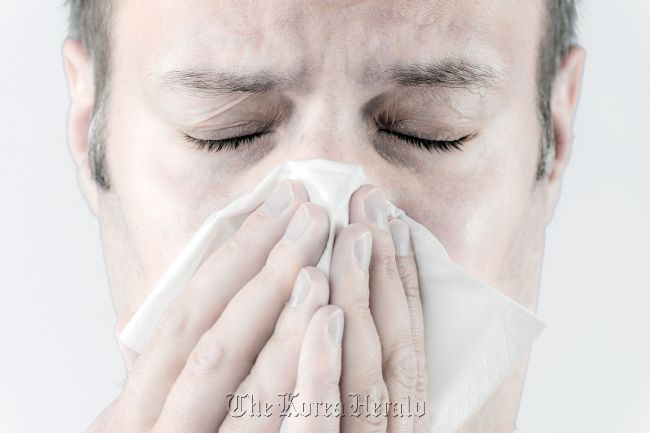As the cold spell tightens its grip on the country, reports of flu-like illnesses have grown in the last few weeks.
Health authorities advised Thursday that people maintain personal hygiene and consider flu shots to avoid illness.
The number of people suspected of having influenza per 1,000 outpatients was 2.8 in the third week of December, a slight increase from 2.7 surveyed a week before, Korea Centers for Disease Control and Prevention said in a report. If the rate reaches more than 4, the health authorities define the influenza virus as being active across the country.

Since the beginning of September last year, 10 flu strains have been reported in Daejeon, South Jeolla Province, South Gyeongsang Province and Gangwon Province. Of the 10 types, three were the H3N2 strain and the rest influenza A(H1N1)pdm09, a common virus type found in the United States, but not in Korea. The disease control agency said the discovery of influenza A(H1N1)pdm09 came as a surprise, as the country had no reports of the virus between September 2011 and August in 2012.
The use of Tamiflu was found to be effective on two cases of the H3N2 strain and one of the A(H1N1)pdm09, but amantadine, another anti-virus medication, proved ineffective as the viruses had developed a resistance, the agency said.
“Acute respiratory cases caused by influenza infection usually peak in December and January and re-emerge in early spring between March and April,” a KCDC official said. “The public needs to pay extra care to avoid getting the virus because it spreads very quickly and easily when a person inhales tiny droplets in the air produced by influenza patients,” the official added.
Influenza symptoms arise after a latent period of one to four days after infection. These symptoms include fever, joint pain in the limbs and severe muscle aches, said Peck Kyong-ran, a doctor at Division of Infectious Diseases at Samsung Medical Center. Elderly patients aged over 65, particularly with chronic diseases or suppressed immunity, and children who are taking aspirin can develop complications, she added.
The most common way to prevent influenza is to have a flu shot.
“Annual influenza vaccines can prevent 70 to 90 percent of influenza so it is currently the best method of prevention,” she said. New vaccines are developed each year to fight against viruses that experts predict will be the most common during the flu season.
The following are tips to avoid influenza, recommended by the KCDC.
1. The influenza vaccine is recommended for children, pregnant women and people aged 65 and over, particularly those with chronic diseases.
2. Maintain personal hygiene and wash hands and brush teeth frequently.
3. Cover your mouth with a tissue or handkerchief when coughing or sneezing, rather than your hands.
4. Wear a facial mask if you have respiratory symptoms or fever.
5. Avoid crowded places.
6. See a doctor if you have influenza symptoms.
By Cho Chung-un (christory@heraldcorp.com)
Health authorities advised Thursday that people maintain personal hygiene and consider flu shots to avoid illness.
The number of people suspected of having influenza per 1,000 outpatients was 2.8 in the third week of December, a slight increase from 2.7 surveyed a week before, Korea Centers for Disease Control and Prevention said in a report. If the rate reaches more than 4, the health authorities define the influenza virus as being active across the country.

Since the beginning of September last year, 10 flu strains have been reported in Daejeon, South Jeolla Province, South Gyeongsang Province and Gangwon Province. Of the 10 types, three were the H3N2 strain and the rest influenza A(H1N1)pdm09, a common virus type found in the United States, but not in Korea. The disease control agency said the discovery of influenza A(H1N1)pdm09 came as a surprise, as the country had no reports of the virus between September 2011 and August in 2012.
The use of Tamiflu was found to be effective on two cases of the H3N2 strain and one of the A(H1N1)pdm09, but amantadine, another anti-virus medication, proved ineffective as the viruses had developed a resistance, the agency said.
“Acute respiratory cases caused by influenza infection usually peak in December and January and re-emerge in early spring between March and April,” a KCDC official said. “The public needs to pay extra care to avoid getting the virus because it spreads very quickly and easily when a person inhales tiny droplets in the air produced by influenza patients,” the official added.
Influenza symptoms arise after a latent period of one to four days after infection. These symptoms include fever, joint pain in the limbs and severe muscle aches, said Peck Kyong-ran, a doctor at Division of Infectious Diseases at Samsung Medical Center. Elderly patients aged over 65, particularly with chronic diseases or suppressed immunity, and children who are taking aspirin can develop complications, she added.
The most common way to prevent influenza is to have a flu shot.
“Annual influenza vaccines can prevent 70 to 90 percent of influenza so it is currently the best method of prevention,” she said. New vaccines are developed each year to fight against viruses that experts predict will be the most common during the flu season.
The following are tips to avoid influenza, recommended by the KCDC.
1. The influenza vaccine is recommended for children, pregnant women and people aged 65 and over, particularly those with chronic diseases.
2. Maintain personal hygiene and wash hands and brush teeth frequently.
3. Cover your mouth with a tissue or handkerchief when coughing or sneezing, rather than your hands.
4. Wear a facial mask if you have respiratory symptoms or fever.
5. Avoid crowded places.
6. See a doctor if you have influenza symptoms.
By Cho Chung-un (christory@heraldcorp.com)
-
Articles by Korea Herald






![[Weekender] How DDP emerged as an icon of Seoul](http://res.heraldm.com/phpwas/restmb_idxmake.php?idx=644&simg=/content/image/2024/04/25/20240425050915_0.jpg&u=)



![[KH Explains] No more 'Michael' at Kakao Games](http://res.heraldm.com/phpwas/restmb_idxmake.php?idx=644&simg=/content/image/2024/04/28/20240428050183_0.jpg&u=20240428180321)







![[Herald Interview] Mistakes turn into blessings in street performance, director says](http://res.heraldm.com/phpwas/restmb_idxmake.php?idx=652&simg=/content/image/2024/04/28/20240428050150_0.jpg&u=20240428174656)
